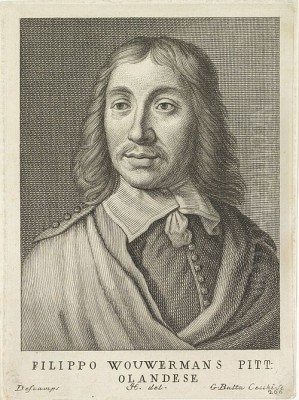
Philips Wouwerman stands as one of the most prolific, versatile, and technically accomplished painters of the Dutch Golden Age. Born into an artistic family in Haarlem, he carved a distinct niche for himself, becoming particularly renowned for his dynamic depictions of horses and riders across a wide range of settings – from elegant hunting parties and cavalry skirmishes to bustling stables and picturesque landscapes. His meticulous attention to detail, sophisticated compositions, and masterful handling of light earned him immense popularity during his lifetime and cemented his legacy, especially among collectors in the subsequent centuries. Though his fame slightly waned compared to some contemporaries in later periods, his work remains a cornerstone of Dutch 17th-century art, celebrated for its elegance, narrative richness, and unparalleled portrayal of the equine form.
Early Life and Artistic Formation in Haarlem
Philips Wouwerman was baptized in Haarlem on May 24, 1619. He was the eldest son of Pauwels Joostens Wouwerman, a painter of relatively modest success who specialized primarily in history painting, and Susanna van den Bogert. Growing up in Haarlem, a vibrant artistic center during the Dutch Golden Age, undoubtedly provided a stimulating environment for the young Philips. His initial artistic training naturally came from his father, Pauwels, although the specific nature and extent of this early instruction remain undocumented. Pauwels' own work, while competent, did not achieve the renown his son would later attain.
Art historical tradition, largely stemming from the writings of Arnold Houbraken in the early 18th century, suggests that Philips may have spent a brief period in the studio of the celebrated portraitist Frans Hals. However, tangible stylistic evidence linking Wouwerman's mature work directly to Hals's bravura brushwork and psychological intensity is scarce. If such an apprenticeship occurred, its impact seems to have been minimal on Wouwerman's developed style, which prioritized detailed rendering and carefully constructed compositions over Hals's looser, more spontaneous approach.
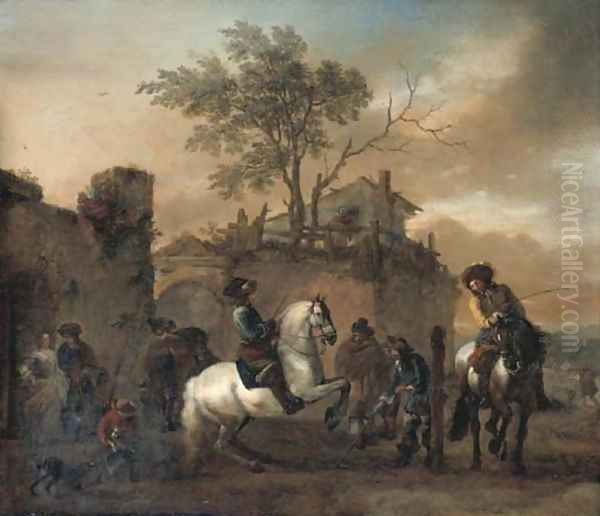
A more formative, though perhaps brief, experience might have been a trip to Hamburg around 1638-1639. Records suggest he worked there in the studio of Evert Decker, a German painter of historical subjects. During this time, Wouwerman also married Annetje Pietersz. van Broeckhof in Hamburg. This journey, undertaken against his father's wishes, indicates an early independence and ambition. Soon after, however, he returned to Haarlem, where he would remain based for the rest of his productive career. He joined the Haarlem Guild of Saint Luke, the city's professional organization for painters and craftsmen, in 1640, marking his official establishment as an independent master.
The Influence of Italy and the Bamboccianti
While Wouwerman himself is not documented as having traveled to Italy, the influence of Italian art, particularly the genre scenes popularized by Dutch and Flemish painters working in Rome known as the Bamboccianti, is palpable in his early work. The leading figure of this group was Pieter van Laer, nicknamed "Il Bamboccio" (meaning "ugly doll" or "puppet"), who had returned to Haarlem from Rome around 1639. Van Laer specialized in depicting the everyday lives of peasants, soldiers, and travelers in Italianate landscapes, often characterized by earthy tones, strong contrasts of light and shadow (chiaroscuro), and a focus on anecdotal detail.
Wouwerman clearly absorbed Van Laer's thematic and stylistic innovations. His paintings from the early 1640s often feature similar subjects – humble figures in rustic settings, stable interiors, roadside camps – and adopt a comparable brownish palette and robust handling of paint. However, Wouwerman quickly began to refine and elevate these themes. While Van Laer's work often possessed a certain raw energy and directness, Wouwerman introduced a greater degree of elegance, technical finesse, and compositional harmony. His figures became more graceful, his landscapes more atmospheric, and his rendering of textures and details, especially on animals, more precise.
This connection to Van Laer later became the subject of an anecdote, again popularized by Houbraken. It was rumored that Wouwerman had acquired a large collection of Van Laer's studies and drawings, using them extensively for his own compositions, and that he burned them shortly before his death to conceal his debt or prevent his less talented brother, Pieter, from relying on them. While this story is likely apocryphal, perhaps fueled by professional rivalry or later embellishment, it underscores the recognized link between the two artists and Wouwerman's eventual surpassing of his initial model in terms of popular success and refinement. Other Italianate painters like Jan Asselijn, Jan Both, and Nicolaes Berchem were also active, creating a broader context of Dutch artists engaging with southern European light and landscape motifs.
Development of a Mature Style: Light, Landscape, and Detail
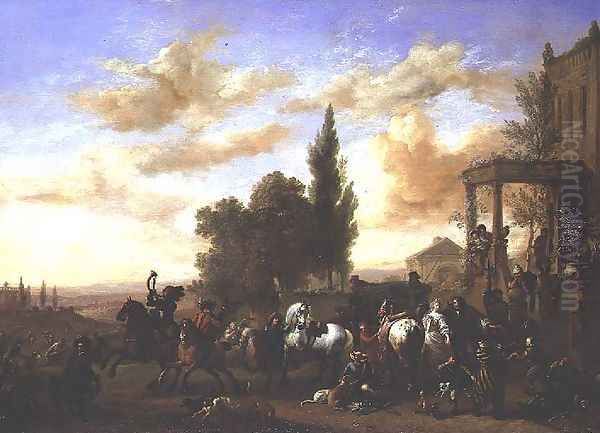
By the mid-1640s and into the 1650s, Wouwerman forged his distinctive mature style. While the Italianate influence remained discernible in certain landscape elements and figure types, he increasingly integrated these with native Dutch traditions of landscape painting, exemplified by artists like Jan van Goyen and Salomon van Ruysdael, though Wouwerman's approach was generally more detailed and colorful. His compositions became more complex and sophisticated, often employing diagonal recessions to create a sense of depth and dynamism.
A key characteristic of his mature work is his masterful handling of light and atmosphere. He often utilized a relatively low horizon line, allowing expansive skies filled with subtly graded clouds to dominate the scene. His lighting became cooler and clearer than in his early works, eventually evolving towards the silvery tonalities for which he is particularly celebrated. This delicate, often cool light bathes his scenes, unifying the diverse elements and creating a palpable sense of time of day and weather. He excelled at rendering atmospheric perspective, where distant objects subtly fade in color and clarity, enhancing the illusion of space.
His attention to detail was extraordinary, particularly in the rendering of figures, costumes, animals, and accessories. Staffage – the small human and animal figures animating the landscape – was never incidental in Wouwerman's work. Each figure is carefully observed and plays a role in the narrative or overall mood of the scene. Whether depicting the elaborate attire of a hunting party, the worn gear of soldiers, or the simple clothes of peasants, he rendered textures and forms with remarkable precision. This meticulousness, combined with his fluid brushwork, gave his paintings a jewel-like quality that appealed greatly to collectors.
Specialization in Equestrian Themes
Above all else, Philips Wouwerman is renowned as a painter of horses. Equine subjects feature prominently in the vast majority of his works, depicted with an anatomical accuracy, understanding of movement, and appreciation for different breeds that was unparalleled among his contemporaries, perhaps rivaled only in focus, though not breadth, by Paulus Potter's depictions of cattle. Wouwerman's horses are not mere accessories; they are often central protagonists, rendered with vitality and individual character.
He explored equestrian themes across numerous genres. His depictions of cavalry skirmishes and battle scenes are filled with dynamic action, swirling dust, and the dramatic intensity of combat. He captured the chaos and energy of horses rearing, charging, and falling, alongside the detailed rendering of soldiers' armor, weapons, and banners. These scenes often reflect the ongoing military conflicts of the era, such as the Eighty Years' War, or serve as more generalized representations of martial life.
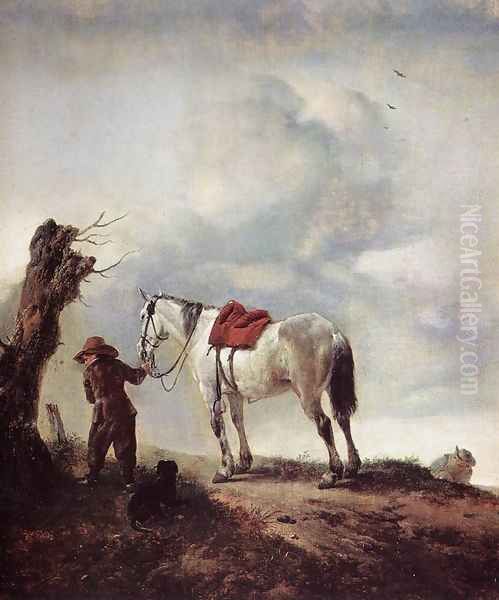
Equally popular were his depictions of hunting parties. These often showcase aristocratic figures elegantly attired, mounted on fine steeds, accompanied by hounds and servants, setting out for or returning from the chase. These works capture the leisure and social rituals of the upper classes, set within beautifully rendered landscapes that range from wooded areas to open fields. The stag hunt was a particularly favored subject, allowing for dramatic compositions involving pursuit and capture.
Wouwerman also painted numerous scenes centered around stables, riding schools, and farriers. These works offer glimpses into the daily life surrounding horses, showing them being groomed, shod, trained, or resting. Paintings like The Riding School demonstrate his ability to handle complex multi-figure compositions within specific architectural settings, combining genre observation with his signature equine expertise. Horse fairs and market scenes provided another avenue to depict a wide variety of horses and human interactions.
The Ubiquitous White Horse
A recurring and almost trademark motif in Wouwerman's oeuvre is the prominent placement of a white or dappled grey horse. This striking animal often serves as a focal point in the composition, drawing the viewer's eye through its luminosity against the typically darker or more muted tones of the surrounding landscape and figures. Its presence provides a point of visual anchor and often highlights the principal figure or action within the scene.
The exact significance of this recurring white horse has been debated. It may simply have been a compositional device Wouwerman found effective for creating contrast and focus. White horses were also highly prized and associated with nobility and command, making them suitable mounts for the aristocratic figures frequently depicted in his hunts and military scenes. Some interpretations suggest potential symbolic meanings related to purity, virtue, or even a subtle signature element. Regardless of its precise intent, the skillfully rendered white horse became inextricably linked with Wouwerman's artistic identity.
Landscapes, Genre, and Other Subjects
While horses dominate his output, Wouwerman was also a highly accomplished landscape painter in his own right. His landscapes provide the settings for his equestrian scenes but are often imbued with their own character and atmospheric beauty. He depicted a variety of terrains, from rolling dunes and wooded areas typical of the Dutch countryside to more mountainous, Italianate vistas, particularly in his earlier works. He was also adept at capturing different seasons, producing evocative winter landscapes complete with frozen canals, skaters, and snow-dusted trees, contributing to a genre popularised by artists like Hendrick Avercamp.
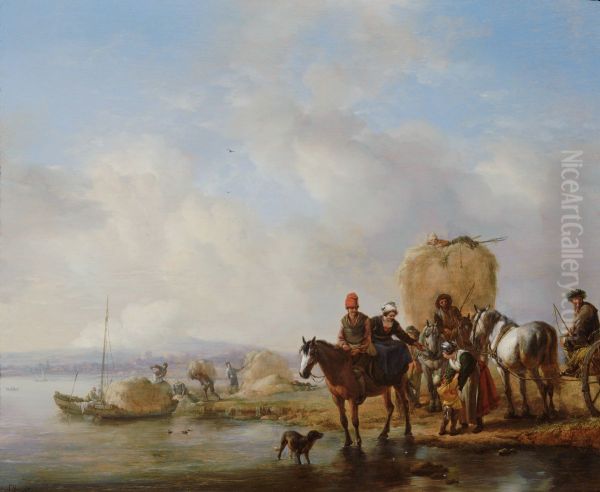
Beyond his primary specializations, Wouwerman occasionally tackled other subjects. He produced a number of genre scenes depicting peasant life, travelers resting at inns, or military encampments, continuing the themes explored by the Bamboccianti but with his characteristic refinement. Although less common, he also painted a small number of religious and mythological subjects. Works like The Annunciation to the Shepherds demonstrate his ability to adapt his landscape and figure painting skills to sacred narratives, often imbuing them with a pastoral charm and atmospheric lighting consistent with his secular works.
Workshop, Family, and Students
Philips Wouwerman was highly productive, with estimates of his lifetime output ranging traditionally up to 1,000 paintings, although modern scholarship, notably the catalogue raisonné by Birgit Schumacher, suggests a figure closer to 600 authentic works. This considerable output implies an efficient workshop practice, although specific details about assistants remain limited. His success allowed him to live comfortably and invest in property.
His artistic inclinations were shared by his two younger brothers, Pieter Wouwerman (1623–1682) and Jan Wouwerman (1629–1666), who both became painters in Haarlem. Pieter closely followed Philips's style and subject matter, particularly the equestrian and military scenes, though generally without achieving the same level of finesse or dynamism. Jan specialized more purely in landscape painting, often depicting dune landscapes around Haarlem in a style closer to that of Jacob van Ruisdael, though sometimes incorporating horses that echo his elder brother's work. The similarity in style, especially between Philips and Pieter, has occasionally led to attribution difficulties.
Philips Wouwerman also took on pupils. Documented students include Nicolaes Ficke, Jacob Warnars (or Warners), Emanuel Murant, and Hendrick Berckman. Others sometimes associated with his studio or influence include Barent Gael and Jan van Huchtenburgh, the latter becoming a notable painter of battle scenes himself. Through his students and the widespread imitation of his style, Wouwerman's influence extended significantly within Dutch art. He also held official positions within the Haarlem Guild of St. Luke, serving as vinder (committee member or dean) in 1645/46, indicating his respected standing among his peers.
Reputation, Legacy, and Market
During his lifetime, Philips Wouwerman achieved considerable success and recognition. His paintings were sought after by Dutch collectors, and his reputation began to spread internationally. However, his fame reached its absolute zenith in the 18th century, particularly in France and Germany. His elegant compositions, refined technique, and appealing subject matter resonated perfectly with the Rococo aesthetic.

Aristocratic collectors, such as Jean de Jullienne in Paris and, most notably, Augustus III, Elector of Saxony and King of Poland, avidly acquired his works. The Dresden Gemäldegalerie Alte Meister amassed an exceptionally large collection of Wouwerman paintings (over 60), reflecting his esteemed status. French engravers widely reproduced his compositions, further disseminating his style and popularity. During this period, his paintings often commanded higher prices than those of many artists now considered giants of the Dutch Golden Age, including Rembrandt and Vermeer.
His reputation experienced a relative decline from the mid-19th century onwards, as tastes shifted towards the perceived realism and psychological depth of artists like Rembrandt or the tranquil landscapes of Ruisdael. Wouwerman's elegance was sometimes seen as superficial or repetitive by critics favoring different artistic values. However, his technical brilliance was never entirely forgotten, and his works remained staples in major museum collections worldwide, including the Rijksmuseum in Amsterdam, the Louvre in Paris, the National Gallery in London, the Wallace Collection in London, the Kunsthistorisches Museum in Vienna, and the Metropolitan Museum of Art in New York.
In recent decades, there has been a renewed appreciation for Wouwerman's artistry. Scholarly attention and exhibitions have highlighted his technical mastery, his innovative compositions, and his significant role within the Dutch Golden Age. On the art market, his works continue to be traded regularly. While prices vary significantly based on size, period, quality, condition, and provenance, prime examples, particularly large-scale, well-preserved hunting or battle scenes, can achieve substantial sums at auction. For instance, The Departure of a Hunting Party fetched over £1.2 million at Christie's, demonstrating the continued high regard for his best work among collectors. Smaller pieces or those with condition issues naturally command lower prices, but the demand for authentic Wouwerman paintings remains steady.
Conclusion: An Enduring Master of Detail and Dynamism
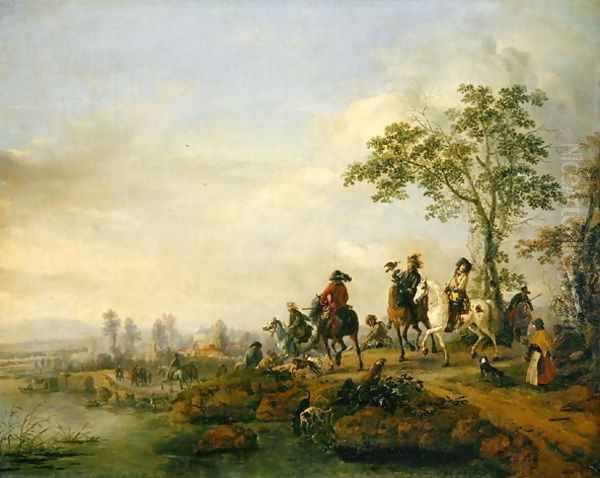
Philips Wouwerman died in Haarlem on May 19, 1668, and was buried in the Grote Kerk (St. Bavo's Church). He left behind a vast and influential body of work that captures the vitality and elegance of the Dutch Golden Age. As a master painter of horses, his skill remains virtually unsurpassed. His ability to combine meticulous detail with dynamic composition, atmospheric landscapes with lively narrative, secured his place among the leading artists of his time. While perhaps overshadowed in popular imagination by some of his contemporaries during certain periods, his technical brilliance, the sheer appeal of his subject matter, and his significant influence on subsequent generations of artists confirm his status as a major figure in European art history. His paintings continue to delight viewers with their intricate detail, sophisticated execution, and enduring depiction of a world animated by the grace and energy of the horse.